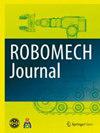Terrain traversability prediction for off-road vehicles based on multi-source transfer learning
IF 1.7
Q3 INSTRUMENTS & INSTRUMENTATION
引用次数: 1
Abstract
In this paper, a novel terrain traversability prediction method is proposed for new operation environments. When an off-road vehicle is operated on rough terrains or slopes made up of unconsolidated materials, it is crucial to accurately predict terrain traversability to ensure efficient operations and avoid critical mobility risks. However, the prediction of traversability in new environments is challenging, especially for possibly risky terrains, because the traverse data available for such terrains is either limited or non-existent. To address this limitation, this study proposes an adaptive terrain traversability prediction method based on multi-source transfer Gaussian process regression. The proposed method utilizes the limited data available on low-risk terrains of the target environment to enhance the prediction accuracy on untraversed, possibly higher-risk terrains by leveraging past traverse experiences on multiple types of terrain surface. The effectiveness of the proposed method is demonstrated in scenarios where vehicle slippage and power consumption are predicted using a dataset of various terrain surfaces and geometries. In addition to predicting terrain traversability as continuous values, the utility of the proposed method is demonstrated in binary risk level classification of yet to be traversed steep terrains from limited data on safer terrains.基于多源迁移学习的越野车辆地形可穿越性预测
针对新的作战环境,提出了一种新的地形可穿越性预测方法。当越野车辆在崎岖地形或由松散材料组成的斜坡上运行时,准确预测地形可穿越性是确保高效运行和避免关键机动风险的关键。然而,在新环境中预测可穿越性是具有挑战性的,特别是对于可能存在风险的地形,因为这些地形的可穿越数据要么有限,要么根本不存在。针对这一局限性,本文提出了一种基于多源传递高斯过程回归的自适应地形可穿越性预测方法。该方法利用目标环境低风险地形上有限的可用数据,通过利用以往在多种地形表面上的穿越经验,提高对未穿越、可能是高风险地形的预测精度。在使用各种地形表面和几何形状的数据集预测车辆打滑和功耗的场景中,证明了所提出方法的有效性。除了将地形可穿越性作为连续值进行预测外,该方法还可以从安全地形的有限数据中对尚未穿越的陡峭地形进行二元风险等级分类。
本文章由计算机程序翻译,如有差异,请以英文原文为准。
求助全文
约1分钟内获得全文
求助全文
来源期刊

ROBOMECH Journal
Mathematics-Control and Optimization
CiteScore
3.20
自引率
7.10%
发文量
21
审稿时长
13 weeks
期刊介绍:
ROBOMECH Journal focuses on advanced technologies and practical applications in the field of Robotics and Mechatronics. This field is driven by the steadily growing research, development and consumer demand for robots and systems. Advanced robots have been working in medical and hazardous environments, such as space and the deep sea as well as in the manufacturing environment. The scope of the journal includes but is not limited to: 1. Modeling and design 2. System integration 3. Actuators and sensors 4. Intelligent control 5. Artificial intelligence 6. Machine learning 7. Robotics 8. Manufacturing 9. Motion control 10. Vibration and noise control 11. Micro/nano devices and optoelectronics systems 12. Automotive systems 13. Applications for extreme and/or hazardous environments 14. Other applications
 求助内容:
求助内容: 应助结果提醒方式:
应助结果提醒方式:


